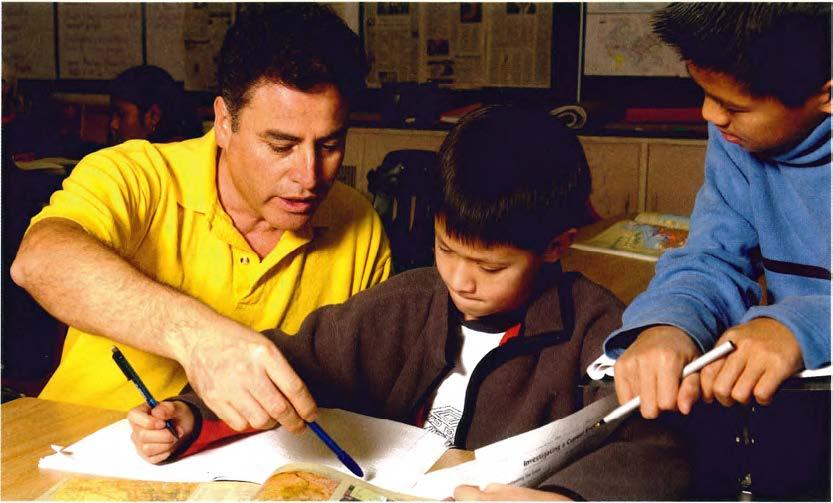
Addressing Boys' Achievement in School
The academic achievement of boys has long been a worrisome issue for educators. The most recent EQAO assessment of Ontario’s grade 3 and 6 students (released last November) does nothing to lessen concern.
In the past, working-class, underprivileged, and disadvantaged boys have not been successful in school, and they continue not to be successful today.
Whereas both boys and girls show improvement, girls continue to do better than boys. However, says Dr. Blye Frank of Dalhousie University, the first question to ask on the subject is: “Which boys are we talking about?”
Dr. Frank is a professor who serves as acting director in the division of medical education and as director of faculty development at Dalhousie’s Faculty of Medicine. He was one of the keynote speakers at ETFO’s 2005 Leadership event, held in conjunction with Representative Council in November.
“I think the serious issue here is that we are treating boys as if they were all the same,” he says. “The analysis is far too simplistic. The issues around boys are complex issues around social class, income, race and sexuality.”
He explains: “In the past, working-class, underprivileged, and disadvantaged boys have not been successful in school, and they continue not to be successful today.
“I would suggest that white upper- and middle-class boys historically have done well in school, and continue to do well. If we are looking for helpful initiatives, then we would continue to have a socio-economic and class analysis. That would give us a whole different perspective.”
Similarly, he adds, “If we look at African- Canadian boys in Nova Scotia, or First Nations boys, we get a different analysis. Once we begin to see people as not just gendered, but raced and classed, then we begin to ask a whole different set of questions.”
The debate about race-based statistics
Dr. Frank is quick to point out that information about race and class must be gathered with extreme care. “The worry, of course, is what people do with these statistics, and rightly so. If you produce statistics that show a poor rate of success in literacy and numeracy in certain groups, then people can use those statistics against that group.”
These comments were mirrored last November, when the Toronto District School Board narrowly voted to move forward on a highly debated proposal to collect race-based statistics.
A lead editorial in Share, the large-circulation newspaper serving Toronto’s Black and Caribbean communities, guardedly supported the proposal, stating, “The data from the kind of statistics the TDSB wants to gather surely will answer some important questions if they are used properly. ... To not support this proposal will leave us with the present system, the same one that has been failing too many of our children. Is that good enough? We think not.”
Ontario education minister Gerard Kennedy, interviewed on the proposal by Toronto’s 680 News, said, "We dont have anything that militates against it, but we aren’t proposing to do that. We were asked to consider it and we’re not proposing to do that province-wide.”
However, Dr. Frank cautions against implementing policy before analyzing these types of data. “I fear we will have a redesign of the curriculum, intended to make it more masculine.
“We’ve had 30 years of serious scrutiny of the curriculum around issues of sexism and heterosexism, and surely what we don’t want to do is remasculinize it,” he says. “I can see coming forth a kind of affirmative action for the hiring of men in the school system.”
Concern about the lack of male teachers, particularly in elementary grades, surfaced again in the fall when the Ontario College of Teachers released a study showing the number of men entering teaching is dropping. The study’s authors called on the government to take steps to reverse this trend.
“I am not at all opposed to more men teaching in elementary schools,” Dr. Frank said. “What I am opposed to is the lack of analysis. If we want to talk about role modeling, we want to talk about what we want modeled. If we’re not careful, this is the reproduction of privilege.”
Solutions require careful thought
Meanwhile, what can be done to address the issue? Dr. Frank breaks solutions down into four areas: language, curriculum, pedagogy and policies. He says teachers can bring about change in the first three areas before school boards move on the fourth. Inclusive language makes a good beginning, as long as it is not based on stereotypical ideas of “what we think boys like.” Furthermore, “Teachers can scrutinize their own curriculum, and ask cWhat does this curriculum hold in place?”’
As for teachers’ practice, “There’s a fabulous study from Concordia that shows that whether it’s a man or a woman teacher, they call boys’ names first. Many teachers will say white boys get the most attention; boys of colour get the second most attention; white girls next, girls of colour last. Teacher attention is one of the most important things, but it’s unequally distributed.
“We have to be very clear about attention to people in terms of gender and race. We must explore assumptions before we get to the policy stage,” Dr. Frank sums up. “I am not opposed to the analysis that we need to look at boys and their success rate, but the question we have to ask is: which boys?”
Sarah B. Hood is a Toronto writer and communications consultant.